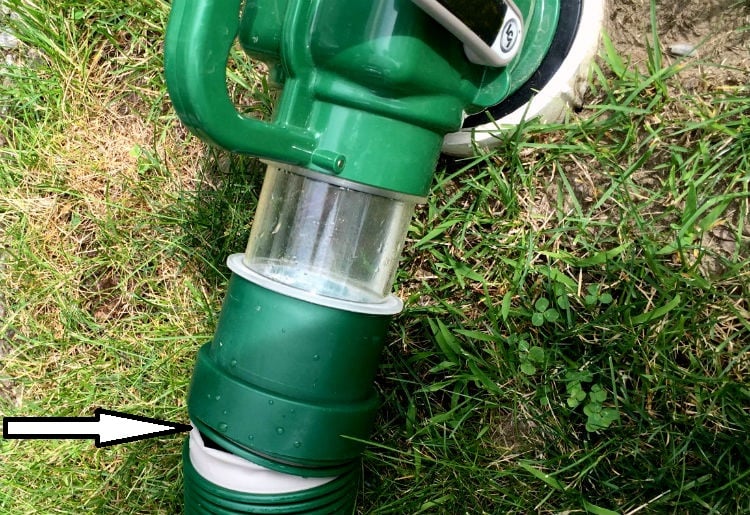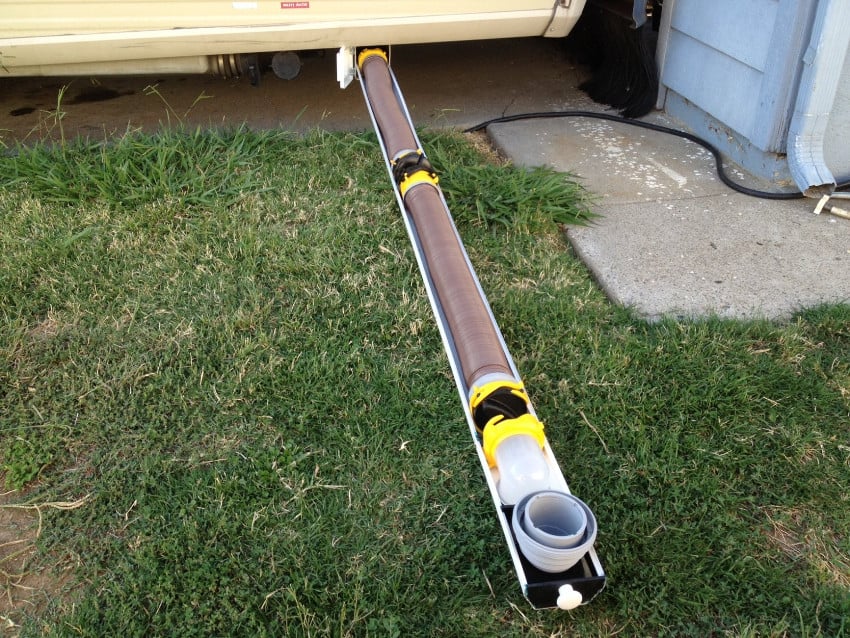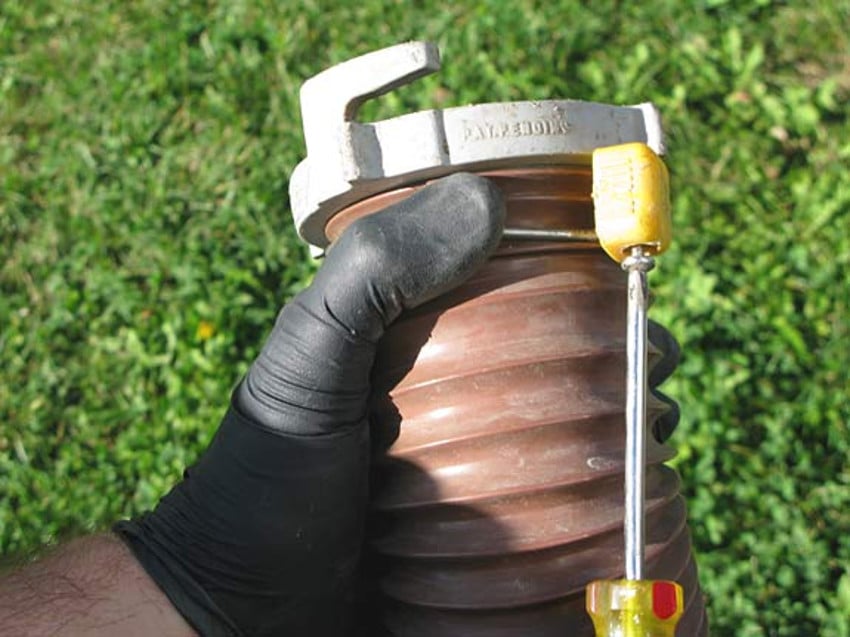RV sewer hose explosion scenes are the stuff Hollywood movies are made of. Who didn’t laugh in when Cousin Eddie dumped his black tank down Clark Griswold’s sewer outlet in the movie Christmas Vacation? Or when Robin Williams’ sewer hose exploded like a volcano in RV: The Movie?

Carefully look for water leaks around the creases. If you see any, you may want to think twice about pulling that black tank lever. Photo by KC iRV2.com member
Odds are good that not a single RVer has managed to avoid some kind of RV sewer hose catastrophe. Every RVer wants to avoid a mess and empty their waste tanks cleanly and easily. But whether you find a crack in the sewer hose or a leaky valve fitting, coming into contact with holding tank waste is inevitable. Even RVers who prefer the advantages of Macerator pump units have their own dump station disaster tales. Whatever type of system you prefer as a full-time RVer, these easy steps can minimize the number of times it happens to you.
Regularly inspect your RV sewer hose
There are many ways to simplify the process of dumping your waste tanks. But a typical “stinky slinky” RV sewer hose will degrade over time and may cause a headache in the long run. UV light damages plastic and the accordion-style creases eventually spring pinhole leaks.

Elevate your hose is one way to avoid it. Image: iRV2 member Winnebeater.
If your sewer hose is constantly exposed or laying on gravel during lengthy stays, be extra vigilant. When you dump your gray water, carefully look for water leaks around the creases and underneath the hose. If you see any, you might want to think twice about pulling the black tank lever.
Buy the hose that other RVers rave about
Cheap RV sewer hoses are fine for the casual RVer, but they don’t last long. Expensive hoses seem like they’ll deliver, but even those tend to fail as well. Always read online reviews for the best RV sewer hoses. Pay for the best one you can and you’ll avoid being the butt of a campfire joke.
Keep your hose away from sharp lawn maintenance tools
When springtime hits, RV park maintenance crews are mowing lawns all afternoon. You won’t probably know that a trimmer line has sliced your hose until you pull the lever to dump. To avoid this, keep your hose elevated. Many full-timers make a RV sewer hose riser to keep their hose off the ground while they sit for long periods of time.
Check the fittings
Fittings commonly fail with cheaper RV hoses. Periodically check the connections for leakages when you’re dumping.
Watch for animal damage
Rodents and mammals tend to have fun with RV sewer hoses. Look at your hose before you dump to ensure a critter hasn’t munched on the plastic.
When in doubt, throw it out
When you RV the good times can last forever. Unfortunately RV sewer hoses just don’t. Even if yours looks fine, it’s a good idea to crack open your wallet every few years for a new hose.
Always wear gloves when dumping
When that moment arrives and your casual dump day culminates with a RV sewer hose explosion, you’ll want a clean set of hands to grab cleanup tools. In the interest of sanitation, use disposable surgical gloves when you pull the valves.
As full-time RVers, we’re exposed to dumping far more than the casual weekender. If you want to be a full-timer you’ll need to put your squeamish nature behind you. Be one with your holding tank waste and when the inevitable happens you’ll be ready for anything.


On my second Rhinoflex in about 8 years (just bought my second one about a month ago. I strongly recommend get the clear connections so you can see when good water is flowing. While I am sure all know this already, its worth say again: Flush black water first, then the gray to clean the pipes. Manage your water. We do out best to dump full or near full tanks, especially the black tank. The fuller the tank the better the digestion and the better the flow, more black, more pressure to clear the tank. Then you want same with your gray, a full tank getting dumped does a better job of cleaning your tanks and the hose.
I usually drain my tanks right before I break camp, leaving the valves open while I am prepping the truck and 5th wheel, the insures a complete drain. I disconnect my hose and CAREFULLY wash it with fresh water inside and out while it still connected to the RV sewer system. I then place it in my holder back bumper) leaving the caps OFF both ends, this allow it to dry out.
I work sans surgical gloves and this makes me more careful. Almost anything coming out of the pipe either came off me or out of me and or my wife. By working sans glove you are more careful with everything you do. Then I keep a good liquid soap in the bay and wash up when finished always.
As for explosions of hose?? I can see no scenario that would case a hose to explode unless you affix the hose to the sewer inlet where it cannot breathe. I sometimes see a macerator affixed to the sewer connection in a rigid fashion, which in my mind begs the question of WHY do that at that point, now you have a sealed connection between sewer and RV and yes this is where you may have a problem with gas and the possibility of an explosion. Macerators, an expensive solution in search of a problem. In fact Camping World and other RV stores are loaded with a lot of very $$$$ solutions in search of problems. My observations the more it cost, the least likely its a remedy for anything other than to take money out of your wallet.
I have been RV’ing for a long time, 5th wheels, Truck slide in campers, Motorhomes, full time and part time. Keep it simple, keep it clean, inspect inspect and a large can of WD 40 is your friend…
17 Oaks
Has the same similar results but I say buy 2 because something that can fail will fail. Mine has never failed . Rhino is the only hose to buy. Elevated risers are for looks just as much as function. Who wants to be like Griswold ? Not me. . Never had a mess as they say ever, Rhino gets it done. And water… simple water spray once a month. You are good. Thanks . I agree 100%.
Sorry but I don’t waste the money on gloves, too many years onboard Submarines. But as far as checking your hoses and replacing them periodically is concerned that is a true statement. Don’t buy the cheap one because it won’t last long and you will be buying another one right after you finish cleaning up the mess you made. As stated always dump the Black tank first and then rinse the hose with the grey tank. If you use one of those bumper stows for your sewer hose then you need to line the bottom of it with something.
I used some 4″ rubber edge molding and cut it down to the proper width. I slid it inside the tube the full length in order to protect the sewer hose when it is slide into it. This would keep form tearing the hose as you put it in and take it out, I also took a piece of wire clothes hanger about 4″ in length and put a slight bend in the middle and attached a piece of string to it that was long enough to reach from one end to the other of the tube plus about 1 foot, I then fixed as place to attached and removed easily the end on the Drivers side to the out side of the tube. I slide the sewer tube on this string when putting it in the tube and use the string to pull it out when needed, because the sewer tube will slide back and forth in the tubed when traveling..
To many years as the school custodian (40+). I use latex gloves.
We full time and I wear heavy rubber gloves in case something explodes and I have to grab the ungrabbable..
I keep the hose in a plastic storage bin in a basement compartment: no sliding, no damage and contained.
I like to run a little gray water through the sewer pipe to wet the hose and than dump the black, flush the black every time, compress the hose as I’m draining the final fluid, no gloves wash up right away with soap and water.
Of the problems that I have see during my RVing is the fact that many who are just starting out fail to educate themselves well enough to stay away from problems with dumping. I feel sorry for those who forget to attach the hose before opening the black water valve and find themselves standing in something that they did not want to stand in and then taking a long time to clean up the problem. I have seen than more than once in one case even an experienced RVer who was distracted. Instead of laughing I was tempted to cry along with those involved Perhaps it would do well for more than one person to know the process when just starting and to have a second opinion to decide if it is time to pull the handle. It is fortunate that many of the dump stations have a small grade to the actual sewer inlet which helps with the process. Another challenge that I have seen and experienced is not knowing for sure that the gate valves are not completely closed when starting out or to have a gate valve that leaks. In that case, if it is possible, to have the hose connected to the line all the time. At least the mess does not get out of control. At least that is what my RV allows me to do.
Probably more by coincidence than good planning, I keep my Little Green Machine (wet-vac/rug cleaner) in the cabinet nearest my water and waste cabinet. It has come in handy when the sewer line backed up below-ground. Cleanup was quick.
I find that dumping about three seconds of gray water first to make sure everything is connected properly and no hose leaks keeps me from having black water accidents.
I use a four foot section of plastic rain gutter as a channel to support the drain hose. It keeps the hose elevated and nice and straight for a good flow. Drain the black first, then grey to wash out the hose then use the water hose to clean the hose after all of the dumping is done. I store the hose in a plastic milk crate and leave the ends open for drying.
Here are a couple of thoughts to perhaps include in a future article about the same.
Many newer RVs come with external water and waste level sensors on their tanks. These will not have the same issues, as the old style feedthough probes do, with tp hanging up on them. This gives you a cleaner flush and more reliable tank readings.
Also, especially if you are a newbie, do a test flush. Just fill your grey tank a bit and then drain it. It will give you a chance to check your connects with much cleaner water.
1) not sure how you could have an explosion in your sewer hose, not going to say it’s impossible because most things are possible, just extremely unlikely.
2) I agree with the article except for one thing, Rubber gloves, I don’t wear them and never have, never will. You want to be careful then don’t waste your time on gloves. After all Aren’t gonna wash your hand anyhow?
July 1967m Cam Rahn Bay, Vietnam: Just off the plane and are standing in formation. 1st Sgt is looking for volunteers and he asks if any of you boys lived on a farm or ranch with a septic system. I and another guy raise our hands. We are on Septic duty. Each morning at 9:30 we meet the duce ‘n half truck and drive around the area and pick the bottom 1./3 rd of a 55 gal drum that sits under a crapper, we load it into the truck and drive to the burn site. There we pour about 5 gal or so into the drum bottom, light it and we report back that eve at 6:30 PM and do it again, rest of the time we are off. In initial brief I ask were we got rubber gloves, 1st Sgt bellowed you don’t need them and that is so you will be careful and not slop chit everywhere…he was right! I learned well,
While we were campground hosts at Mather Campground in Grand Canyon, ravens pecked numerous holes in my brand new 25′ top-of-the-line sewer hose. Tried patching with 3″ gorilla tape – didn’t work.
After dump, I make a “U” (upright) with waste hose, completely fill, then dump the hose. Really gets it cleaned out.
Exceptionally hot summer in Texas and I observed a slight bubbling at one of the hose ribs on top. Nowhere else. I temp patched with rv goop. The patch held fine but 3 more areas next dump… and even more following. We are full time so the hose was not subjected to moving or handling. All leaks had occured topside of a fairly new costly hose. I replaced, but mentally credited the leaks to the unbeearably hot sun heating the wire ribs daily to the point of baking or melting the plastic hose right at the wires. My cure was to coat the top of the hose with a highly reflective aluminum spray paint, reflecting off the heat and UV rays. No trouble since… still watching. My next move is to get my temperature gun from the truck and do a more scientific test, aluminum hose vs untreated hose. This should upset the manufacturers hey?
If you have dry/chapped skin on your hands or a pet has made a slight scratch, or bumped a knuckle you could have an opening in the skin that bacteria could enter before you have time to wash it really good in soapy water. Why take the chance? Use a good pair of rubber gloves just in case.